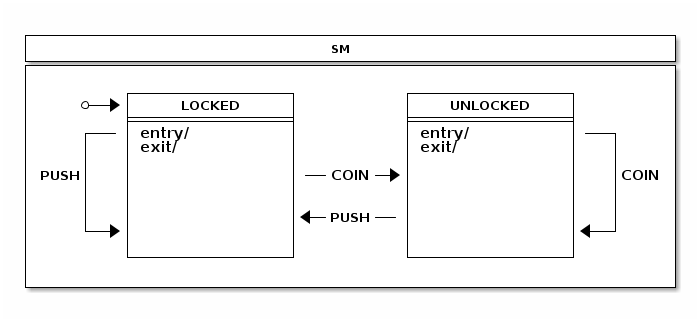Turnstile is a simple device which gives you an access if payment is
made and is a very simple to model using a state machine. In its
simplest form there are only two states, LOCKED and UNLOCKED. Two
events, COIN and PUSH can happen if you try to go through it or
you make a payment.

States.
public enum States {
LOCKED, UNLOCKED
}
Events.
public enum Events {
COIN, PUSH
}
Configuration.
@Configuration @EnableStateMachine static class StateMachineConfig extends EnumStateMachineConfigurerAdapter<States, Events> { @Override public void configure(StateMachineStateConfigurer<States, Events> states) throws Exception { states .withStates() .initial(States.LOCKED) .states(EnumSet.allOf(States.class)); } @Override public void configure(StateMachineTransitionConfigurer<States, Events> transitions) throws Exception { transitions .withExternal() .source(States.LOCKED) .target(States.UNLOCKED) .event(Events.COIN) .and() .withExternal() .source(States.UNLOCKED) .target(States.LOCKED) .event(Events.PUSH); } }
You can see how this sample state machine interacts with event by
running turnstile sample.
$ java -jar spring-statemachine-samples-turnstile-1.0.0.BUILD-SNAPSHOT.jar sm>sm print +----------------------------------------------------------------+ | SM | +----------------------------------------------------------------+ | | | +----------------+ +----------------+ | | *-->| LOCKED | | UNLOCKED | | | +----------------+ +----------------+ | | +---| entry/ | | entry/ |---+ | | | | exit/ | | exit/ | | | | | | | | | | | | PUSH| | |---COIN-->| | |COIN | | | | | | | | | | | | | | | | | | | | |<--PUSH---| | | | | +-->| | | |<--+ | | | | | | | | +----------------+ +----------------+ | | | +----------------------------------------------------------------+ sm>sm start State changed to LOCKED State machine started sm>sm event COIN State changed to UNLOCKED Event COIN send sm>sm event PUSH State changed to LOCKED Event PUSH send